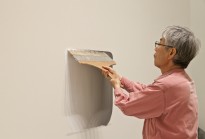A Modest Encounter with Lee Ufan
GALO: Describe your creative process. What do you like to do before you start working on a project? During? Any rituals?
LU: I collect my senses calmly and draw long, deep breaths for quite a while, then gather all the equipment needed for working, which raises the level of concentration.
GALO: What materials do you usually like to use when painting? When sculpting?
LU: For painting, there are custom-made canvases, colors, brushes, as well as my hands, which in their predetermined plan are all appositive. As for my sculptures, I use natural stones that are commonly existent around us, and steel plaques, rendering them in a term of relationship. And it is in such relationships between the industrial and the natural that I would like the spectators to perceive, [affectionately] the infinity.
GALO: How does it feel to have a retrospective of your artwork showcased at one of the most prestigious museums in the world – the Guggenheim?
LU: One memorable point of exhibiting at [the] Guggenheim was the entrance leading to the interior that creates a curving upward slope, a trait that distinguishes it from the conventional White Cube. The challenge was to make sure that my works [would] blend into this particular environment. However, such instability was to be availed of, and there exists direct sensation that can be [awakened] closer to our bodies, making it a very [stimulating] exhibition.
GALO: I read somewhere that last October you were picking out stones in Long Island, especially around the Hamptons area, for your present exhibition at the Guggenheim Museum in New York. What specifications were taken under consideration when you were selecting them? What were you envisioning?
LU: The point is definitely not to exhibit some handsome looking stones that are pleasing to see. The standard of choice was based on how neutral they looked as a natural being. I look for the sense of temporality that it holds as an existential marvel, radiated from stones. Perhaps upon occasions, stones and plaques could come into my mind after a certain concept occurs to my awakening, or it could be the concept that sets up the ground for a new work. All these call upon each other to be evoked.
GALO: I believe that there are approximately 90 of your works on display at the Guggenheim right now, ranging from your paintings and drawings to your sculptures. Is there one that you would say is your favorite or perhaps one that has an interesting story behind it that you feel especially connected with?
LU: There is a raison d’être [reason for being] and a story for every work that I do. But if I were to pick one example, it would be the wall painting, the working duration and the amount of work for which was the most challenging amongst others. One staff member, from the installation team, called the room “lofty” with the hands posed on the chest.
GALO: What do you hope that viewers will take away by viewing your diverse artwork at the Guggenheim? Is there a particular message that you strive to get across through your art?
LU: I hope that the spectators will try to sense the work with all parts of their body before attempting to give personal interpretations right away. In today’s [world], it is easy to consign the importance of works of art and their visual aspects to utterance and communication. This is of course not harmful to the nature of art, but it is my personal belief that an exhibition would radiate a vibrating resonance to the people who perceive it: between body and the space.
(Article continued on next page)

